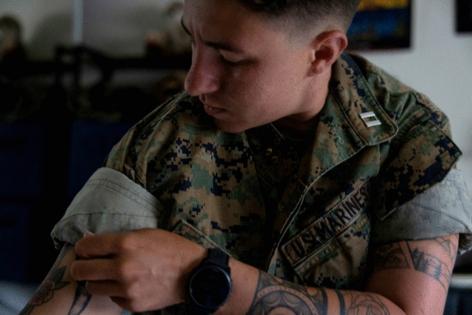Stay or go? For some transgender San Diego sailors and Marines, Trump's ban leaves one option: 'Come and find me'
Published in News & Features
Saddie Kolterman imagines she’s on a sinking ship. The room she’s in is slowly filling with water. She can see a window to escape, but it’s just out of reach. Even if she does get out, she has no idea what she’ll find beyond — an island, or just an expanse of open ocean.
For the 26-year-old, life in the U.S. military is all she has ever known. Now, the Trump administration’s ban on transgender troops from the military is leaving her adrift — an apt analogy for the U.S. Navy air control officer.
“I grew up in a military family. I grew up all around it … and I had a desire to do that,” Kolterman said. “If you were to sit down and ask me, ‘When you get out of the service, what’s your plan?’ I have no idea. I don’t have a dream.”
Service members like Kolterman who call San Diego home are thinking about what life will look like after the military — an institution they have built their lives around, and that is now forcing them to leave.
Collectively, they have decades of experience, ascending to some of the highest ranks of the service, and they aren’t leaving due to misconduct. But under President Donald Trump’s executive order, “Prioritizing Military Excellence and Readiness,” they are no longer seen as fit to serve.
“The emotion is one of betrayal,” said Veronica Zerrer, an Army veteran who serves on the California Veterans Board and co-chairs the San Diego LGBT Community Center’s Veterans Wall of Honor. “They feel betrayed by their commands, by their country.”
For months, uncertainty has swirled around the policy and how it would be fully implemented. And some service members wonder how San Diego’s own military community will be impacted, especially if members end up leaving the region when they leave the service.
The policy was enacted by executive order in January, then temporarily blocked by a federal court in March. But in May the U.S. Supreme Court allowed the ban to take effect while legal challenges proceed.
The Trump administration told transgender troops that they could voluntarily leave the service with an honorable discharge and additional separation pay, or wait to be forced to leave, with unclear repercussions.
“Expressing a false ‘gender identity’ divergent from an individual’s sex cannot satisfy the rigorous standards necessary for military service,” its order read.
It’s unclear how many transgender people are actively serving. The U.S. Department of Defense estimates there are about 4,240 people with a diagnosis of gender dysphoria — around 0.2% of the 2 million service members.
Not all transgender people have experienced gender dysphoria, and not all people with such a diagnosis are transgender. But the diagnosis is the military’s best way of tracking the numbers of transgender people serving.
Active duty troops had until June 6 to voluntarily separate, and National Guard and reserve members had until last Monday.
But after dedicating their lives to the U.S. military, service members feel disrespected and see the move as part of the Trump administration’s broader efforts to erase transgender people and their identities from across the federal government and beyond.
“So much of the senior leadership doesn’t want me there,” said A., who works in the U.S. Navy’s Nuclear Propulsion Program.
She is choosing to stay in the Navy. The San Diego Union-Tribune is identifying her by an initial because she fears being identified and expelled by the service.
“Even if an outright ban does not remain, there’s still a lot of things that I think the political factions in the military leadership would try to change in order to make life more hostile towards trans people,” she said.
San Diego has one of the largest military communities in the country, but the Department of Defense did not respond to the Union-Tribune’s questions about how it might staff positions left vacant once service members are forced to leave.
Local resources for service members impacted by the policy are expanding, and the San Diego LGBT Community Center is working with the California Department of Veterans Affairs and San Diego Veterans Coalition to provide support to transgender service members exiting the service.
As Ron Stark, the board president of the San Diego Veterans Coalition, sees it, that support could be the lifeline troops need to succeed in the transition into civilian life, where they could face trouble finding work and adjusting to new environments.
“People who are connected fare better than those who are not,” he said.
‘No way out of this’
Kolterman’s commitment to the armed forces has outlasted two Trump bans, and brought a defiant return.
She first enlisted in the Army — and was forced to leave — during the first Trump administration’s ban on transgender troops in 2017.
She waited four years to return to the service. Now she’s been in the Navy for nearly three years, stationed in San Diego for the past two.
She has chosen to stay in the Navy under Trump’s ban, though she knows the military can easily identify transgender service members — senior leadership has access to all members’ medical files to ensure they remain fit for service.
The Defense Department has said service members who have ever been diagnosed with gender dysphoria will be identified through individual medical readiness programs, which may vary per branch.
Kolterman is only working a couple days a week, on the far side of the base in a room by themselves. Her hours were reduced in case she had to go on administrative leave — a way for commanders to mitigate the impacts of the policy and buy time for affected service members.
Sam Rodriguez is on administrative leave from the Navy and not working at all — but unlike Kolterman, they decided to take a voluntary separation from the service.
The lieutenant junior grade and medical corps officer initially had good reason to stay: They had just been selected for a promotion from enlisted to officer last fall, and their commissioning was held in April.
“I was going to dig in my heels and stick this out as long as I could,” Rodriguez said.
Rodriguez has a master’s degree in social work, and the promotion would open the door to completing the hours needed to earn a clinical social work license.
But with the Supreme Court’s ruling in May clearing the way for Trump’s ban to take effect, the orders for Rodriguez to transfer were canceled.
“It really sent a very clear message to me that there’s no way out of this,” they said. “The end result is the same.”
Rodriguez now feels their decision to leave gives them some control over the situation. They requested a separation date this fall, though the Navy hasn’t yet issued official separation dates.
For others, such as A., choosing to stay is a point of practicality.
Before she’s forced out, the 29-year-old wants to finish a training course for nuclear trained officers in August — a course she says will make her more competitive for a job in nuclear energy after the military.
Currently on sea command, stationed in part out at sea, she also wants to experience a shore command. She hopes to go to the Mariner Skills Training Center and learn to become an instructor for how to navigate ships safely.
“There’s a certain amount of personal pride in being able to say that I completed all of the things that I set out to do,” A. said.
‘They can come and find me’
For Marine Corps Capt. Sye Savoie, staying is an act of resistance — especially since the ban is only the latest emotional blow as they reflect on their time in the service.
Ten years ago, when Savoie went through rigorous six-week training with other young officers, they felt connected to the group, its character and fraternity. They felt like they belonged.
But as the years went on, Savoie said they saw a darker side, describing a culture of White toxic masculinity. Women they knew experienced sexual assault and harassment, and they say they saw the number of women and people of color in the service around them dwindle.
And even as Savoie rose in the ranks, they were never fully on the inside.
“If I ever felt like I fit in in this organization, I really didn’t,” Savoie said. “That’s been a hard pill to swallow, for something that’s been wrapped in my identity for so long.”
Trump’s ban is a cruel and targeted policy, Savoie says. They’re choosing to remain in the service — opting for involuntary separation, whatever that will come to look like.
“At this point, they can come and take it,” they said. “They can come and find me, and they can tell me word for word why I’m not fit to do the job that I was selected so carefully from so few people to do.”
But for Savoie, there are already ominous signs of the reality of the policy taking shape.
Their medical provider told them that their medical file has been marked, but it’s unclear what that means. And a gender-affirming surgery they scheduled for the fall was canceled last month. Savoie is now desperately trying to contact their provider to see if there’s a way to pay for it out of pocket.
They’re also worried about how the Department of Defense will categorize the separation of service members leaving involuntarily.
Per Pentagon guidance, “officers will be processed for separation on the basis that their continued service is not clearly consistent with the interests of national security,” using a code that could make it harder for them to get another job or security clearance for government work.
A. also worries about this — especially since she hopes to continue working in nuclear energy after she is forced to leave the service.
She expects the people who process security clearances would understand the nuances of how the code is being used. But she worries hiring managers might not, and might assume she couldn’t hold a security clearance.
“That would be, I think, a bigger problem, where there would be more potentially inadvertent discrimination against service members that are separated under this policy,” she said.
A plan forward
Originally from Atlanta, Savoie wants to stay in California. They bought a house in Oceanside in 2023, but it’s daunting to think about how they’ll pay the mortgage once they are booted from the service.
Kolterman expects to move back to Ohio, where her spouse lives, after she’s separated from the Navy. There, she’ll be glad to focus more on their relationship. Already, her service has been one of sacrifice for both of them.
Kolterman isn’t sure how she’ll earn a living next. She’s thinking about what she could do in Ohio with her sociology degree, or even with a social media following on Twitch, the livestreaming video game platform.
And she’s grown to love San Diego. She’s involved in the cycling community and has volunteered with the Coronado Wine Festival and LGBTQ+ advocacy groups, and she wonders how their local communities will change as other service members like them leave the city under Trump’s ban.
“I like to think that there’s a mixing between the military culture and the San Diego culture,” Kolterman said. “It’s gonna be sad to lose a lot of that trust — to have a lot of those people have to pack up and go home.”
For their part, Rodriguez wants to continue doing advocacy work; they plan to move to Washington, D.C., in the fall with their wife and two young children.
And they’re helping fellow transgender service members navigate similar challenges of their own as member director at SPARTA Pride, an advocacy nonprofit for trans people in the military.
“It’s been really hurtful to see and to witness and to walk people through these situations,” they said.
Among the questions they’re asking about what’s next: How will the military fill all their soon-to-be-vacant jobs?
Although numbers are rising, the U.S. military has struggled for years to reach its recruitment goals. And according to the U.S. Army Recruiting Command, more than 70% of American youths don’t qualify for service due to health issues, drug use, misconduct or other problems.
Meanwhile, decades of experience and millions of dollars have been invested in training the transgender members who are now being separated, Rodriguez points out.
“The DoD cannot, one for one, replace us overnight,” they said. “That’s a lot of experience and education and value that they bring to the military that is now going to be lost.”
_____
©2025 The San Diego Union-Tribune. Visit sandiegouniontribune.com. Distributed by Tribune Content Agency, LLC.







Comments